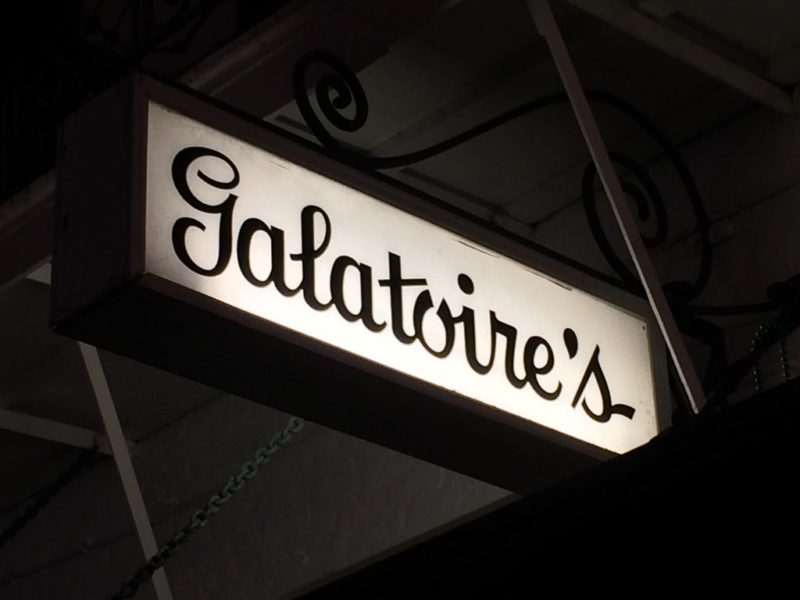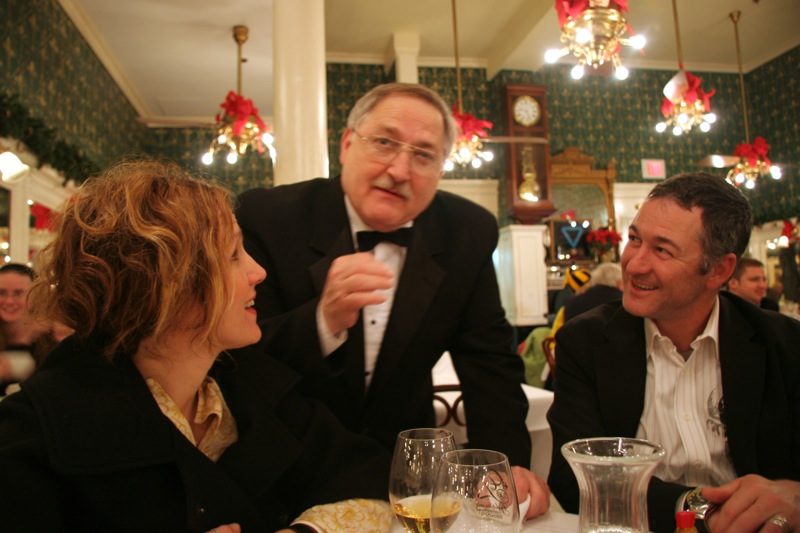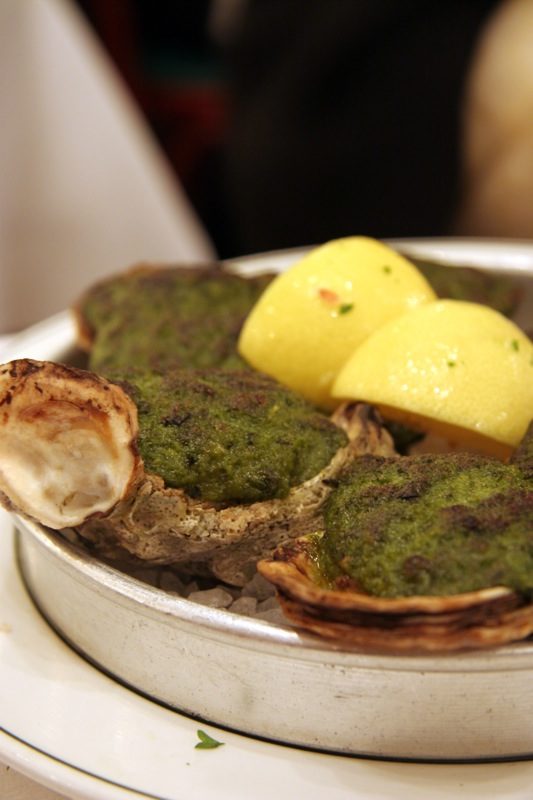Galatoire’s is a New Orleans restaurant known for its old-fashioned French-Creole atmosphere. Located on Bourbon Street, this restaurant receives much exposure from both natives and tourists. Its festive and elegant service gives off the precise vibe people associate with the city known as “the Big Easy.” With styles borrowed from both French recipes and New Orleans methods, Galatoire’s remains a social landmark for city attractions. (www.galatoires.com)
Galatoire’s founder, Jean Galtoire, was born in the small French village of Padries in 1854. He first immigrated to America in 1874 with his wife, Gabrielle. After living in Birmingham and Chicago, he finally settled in New Orleans in 1900 because of its large French population and penchants for food preparation. Over the next few years, he worked at a local Canal Street bar and learned the trades of chefs in the area. Eventually, Galatoire met and befriended Victor Bero, owner of Victor’s Restaurant on 209 Bourbon Street. Through their mutual love of French style and recipes, Galatoire developed experience in the business to the point of co-ownership of the restaurant. In 1905, Galatoire officially purchased the business and re-titled it Galatoire’s, though some evidence indicates a change in name prior to purchase. In 1911, he also formally purchased the building for 25,000 dollars, furthering his own business in the area. Galatoire’s eventually gained popularity as one of the city’s finest restaurants with meals second only to France.

Galatoire’s illuminated black-and-white sign stands out from the frantic neon ofnBourbon Street at night. Photo by Nick Sherman with permission under the Creative Commons
After establishment, Galatoire employed his three nephews as apprentices, two of which joined him during his work on the Canal Street bar. Justin, Leon, and Gabriel Galatoire later purchased the business from him for 40,000 dollars in 1919 following Jean’s retirement and eventual death. Their dedication to the restaurant continued until their own deaths and succession by their New Orleans-native children. Many of the traditions currently upheld at Galatoire’s derived from the leadership of Galatoire’s nephews including the high standard dress code, the equal treatment of customers, and the closing on Mardi Gras. Drawing from recipes from his native town, Galatoire and his nephews created a menu and environment that is still used today (https://d1fkwa1hd8qd6y.cloudfront.net/FAC7232F-1B5F-434C-BA49-99BE850A5A91/3892b5aa-dfe2-4370-925d-c855170b8098.pdf; Burton, Marda and Holditch, Kenneth. “Galatoire’s Biography of a Bistro.” Hill Street Press, 2004. p. 1-19).
Galatoire’s provides a sophisticated atmosphere despite its proximity to more rambunctious areas in the French Quarter. Its use of lights, mirrors, and familiar recipes exhume both a formal environment for the restaurant’s reputation and a laid-back acknowledgement of the city’s casual attitude. One of its methods of allowing such activity is the delivering of both preference for customers and equal treatment (Burton, Marda and Holditch, Kenneth. “Galatoire’s Biography of a Bistro.” Hill Street Press, 2004. p. 91).
Galatoire’s custom of the line outside the restaurant prior to the renovations relates to this casual environment for both regulars and new customers. Although lengthy and sometimes dreary, customers feel privileged to wait as a part of the experience. Under the original policy of no reservations, no one was above standing outside waiting for a table or paying for someone to take a place. Celebrities, family members, and even world leaders recall standing outside with lower class natives for a table at Galatoire’s. As a result, the line became a visual icon of the restaurant, sorely missed, but not extinct, after the renovations. While the addition of the second floor made seating more efficient, customers usually preferred the visual appeal of the older main floor, making them willing enough to stand and wait (Burton, Marda and Holditch, Kenneth. “Galatoire’s Biography of a Bistro.” Hill Street Press, 2004. p. 131-140).
Certain holidays play large roles in the amount of people who attend lunch. The most popular moments for meals and social gatherings were Friday lunches, born out of the New Orleans way of life. Businessmen and party-goers would gather to enjoy the food and each other in a most friendly and outgoing environment. The most popular days for the restaurant would then be the Fridays before Mardi Gras. Ordinary rambunctious events grew larger and louder in celebration for the season. Because the restaurant is closed on Mardi Gras, customers frequently use the Friday before as a time to gather and celebrate, especially due to the close distance to strip clubs and sex shops. Other Fridays before holidays such as Christmas, Halloween, and Easter allow waiters and customers an opportunity to dress and decorate out of normal expectations. On certain years, some holidays would fall on Fridays and provide even more extravagant behavior (Burton, Marda and Holditch, Kenneth. “Galatoire’s Biography of a Bistro.” Hill Street Press, 2004. p. 145-158).
In addition to Friday lunches, Sunday lunches play a significant role for the restaurant. While Fridays are reserved for outrageous parties, Sundays usually involve family gatherings and special occasions. Wedding receptions, New Years Eve parties, and birthdays often celebrate at Galatoire’s, bringing together family members from at least three generations. In contrast with the wild Friday lunches, Sunday lunches range from children on their first birthday and senior citizens celebrating their fiftieth anniversary. Often, birthdays involve a celebratory response from the staff, while proposals are not uncommon in the friendly, romantic atmosphere (Burton, Marda and Holditch, Kenneth. “Galatoire’s Biography of a Bistro.” Hill Street Press, 2004. p. 163-182).
Until the 1980’s, Galatoire’s maintained a strict dress code supported by the traditions of the older New Orleans natives. The code included the requirement of men to wear jackets and ties past five, and women to wear skirts of an appropriate hemline. Because of the popularity of tourism, Galatoire’s has revoked some of its rules to include shirtsleeves at lunch though it still forbids t-shirts and shorts. Although some of the stricter rules have since been abolished, the restaurant still retains a high standard for its customers that is usually reciprocated through elegant wardrobe (Burton, Marda and Holditch, Kenneth. “Galatoire’s Biography of a Bistro.” Hill Street Press, 2004. p. 85-192). In keeping with tradition, lunches begin at about noon and end only when the customers leave which can be as late as five in the afternoon. At five, the restaurant begins its dinner menu. (www.galatoires.com)
Galatoire’s resides on 209 Bourbon Street, the same location of its inception in 1905 (www.galatoires.com). It is a three-story building constructed in the 1830’s to resemble a townhouse. The third floor was often used as a sleeping quarters for Galatoire and his family during their time of work (Burton, Marda and Holditch, Kenneth. “Galatoire’s Biography of a Bistro.” Hill Street Press, 2004. p. 3-7).
In 1999, the building underwent massive reconstruction that had been previously rejected by older managers. In 1997, new manager Melvin Rodrigue gave first plans for renovations that were initially discouraged by local feedback. The reconstruction involved massive improvements to the second floor dining room, allowing for twice as many customers as well as a new bar, a second kitchen, and an elevator. With an increase in tables, the restaurant opened its first reservations for its second-floor dining while still allowing first-come, first-serve preferences for first-floor tables. Other renovations included the reformation of the first-floor kitchen giving more ventilation to chefs and waiters. Despite the construction of a new kitchen on the second floor, business continued through renovations, only closing down for two weeks. Still, most people prefer the atmosphere of the first floor to the newer, less sophisticated environment of the second (Burton, Marda and Holditch, Kenneth. ”Galatoire’s Biography of a Bistro.” Hill Street Press, 2004. p. 209-219).
In 2005, following Hurricane Katrina, Galatoire’s opened a second restaurant in Baton Rouge titled Galatoire’s Bistro, marking the first extension of the business. Galatoire’s Bistro opened in response of many New Orleans natives who migrated to the neighboring city to escape the storm. While the original Galatoire’s closed until January 2006, the Baton Rouge location managed with many similar waiters and chefs as well as the executive manager. Unfortunately, in 2011, Galatoire’s Bistro closed down in search for a new location (http://blog.nola.com/brettanderson/2005/10/galatoires_no_centuryold_insti.html) However, Galatoire’s Bistro is now set to re-open in December 2012 in a new location in Baton Rouge(www.galatoiresbistro.com). According to NOLA.com, in 2012, Galatoire’s purchased a vacant three-story building in hopes of expanding its second floor dining (http://www.nola.com/dining/index.ssf/2012/08/galatoires_purchases_adjacent.html).
Galatoire’s is a fourth generation business featuring the grandsons of Jean Galatoire’s nephews as presidents, managers, waiters, and chefs. Unlike other restaurants of the time, Galatoire’s passed its ownership through different family members rather than a sole recipient. Melvin Rodrigue currently oversees production with David Gooch, Justin Fey, and Michele Galatoire, grandchildren of Leon and Justin Galatoire, Jean’s nephews. (www.galatoires.com)

Waiters form authentic relationships with their regulars. Photo by Pim Techamuanvivit.
The working staff consists of 29 people, 22 men and seven women, of different backgrounds and personalities workings as waiters, busboys, and matrie’ds. While some maintained a solemn, serving demeanor, other waiters provide entertainment through positive interaction and advice on meals. Many waiters serve for periods of decades, sometimes under family guidance, because they prefer the ongoing environment of the restaurant. Training programs for waiters include working in the kitchen for two days, working tables for another two days, and shadowing an experienced waiter for a final two days. Unlike most restaurants, Galatoire waiters do not have assigned tables but function on regular customer requests for particular servers. Waiters value customer loyalty by carefully preparing and anticipating regular orders to perfection. Customers often know waiters by first name and request them as such to avoid confusion. Because of this, Galatoire’s sets up a limit of five tables to prevent overworking waiters. However, some waiters find indirect ways of working around the quota method, assuring regular customers of their favorite waiters. This assists in payment as most of a waiter’s paycheck relies on tips. (Burton, Marda and Holditch, Kenneth. “Galatoire’s Biography of a Bistro.” Hill Street Press, 2004. p. 67-86)
Chefs also work for periods of years before ultimately retiring. Until the 1960’s most of the chefs were native French cooks brought in from the country itself out of tradition for Jean Galatoire’s hiring of French chefs from his native home. Now, most chefs, referred to as cooks to avoid creative infringement and celebrity status, simply apply for work usually under the guidance of current family members on staff. In 1997, Galatoire’s hired its first executive chef, adhering to the modern methods of running a kitchen and placing credit to a single worker. Still, the restaurant mostly functions on the combined effort of its workers rather than the success of one person. Today, Michael Sichel serves as executive chef over a staff of more than 30 people. (Burton, Marda and Holditch, Kenneth. “Galatoire’s Biography of a Bistro.” Hill Street Press, 2004. p. 25-42)
Galatoire’s is opened everyday but Monday. It opens at 11:30 a.m. Tuesday through Saturday and noon on Sunday. The restaurant closes at 10 p.m. everyday, usually after extending its lunch hours. (www.galatoires.com)

Carefully crafted Oyster Rockefeller. Photo by Pim Techamuanvivit
Galatoire’s features recipes and dishes based on a French heritage. Throughout the 1950’s and 60’s, Galatoire’s became a prime source of traditional Creole meals such as Crabmeat Maison and the Shrimp Rémoulade. Many recipes come from memory or hand-written accounts from Jean Galatoire’s own purchases. Other meals develop over time with different chefs adding their personal touch. This unique method developed from Galatoire’s acquiring of French chefs in its early stages. Due to the penchant for memorized recipes, chefs and waiters often serve customers their regular orders even after they are taken off the menu. Customers value the ongoing meals that persist through decades of changes and renovations such as the Trout Marguery, Oysters en Brochette, and the Pommes de Terre Souffle. (Burton, Marda and Holditch, Kenneth. “Galatoire’s Biography of a Bistro.” Hill Street Press, 2004. p. 40-42.)
Ingredients for meals are nearly always kept fresh. Supplies are ordered for use that day and paid with cash on the spot. Chefs inspect ingredients and promptly sent back any that do not seem adequate. Workers particularly inspect seafood due to its abundance in New Orleans food. A weekly purchase includes 600 pounds of shrimp, 55 gallons of soup, 35 gallons of gumbo, 600 pounds of crabmeat, 50 gallons of oysters, 1,500 pounds of fish, 500 pounds of beef, and 300 pounds of lamb. (Burton, Marda and Holditch, Kenneth. “Galatoire’s Biography of a Bistro.” Hill Street Press, 2004. p. 32-33)
Keeping with tradition, Galatoire’s does not take reservations for its first floor and works on a first-come, first-serve basis. However, it does allow reservations for its second-floor dining. The area is non-smoking. (https://d1fkwa1hd8qd6y.cloudfront.net/FAC7232F-1B5F-434C-BA49-99BE850A5A91/3892b5aa-dfe2-4370-925d-c855170b8098.pdf) (www.galatoires.com)
Galatoire’s has produced at least two cookbooks since its opening with recipes by Leon Galatoire. (http://www.amazon.com/Galatoires-Cookbook-Recipes-Time-Honored-Restaurant/dp/0307236374) (http://www.amazon.com/Leon-Galatoires-Cookbook-Galatoire/dp/0882899996)
Galatoire’s has received many awards and recognition for both its food and atmosphere. It has been placed among the top ten restaurants in New Orleans for the past six years. (http://www.nola.com/dining-guide/index.ssf/2009/10/galatoires_1.html) Gourmet Magazine once placed Galatoire’s on the United States’ Most Outstanding Restaurant while referring to it as “a place where time and the outside world pleasantly fade from consciousness.” The Nation’s Restaurant News presented the restaurant into the Hall of Fame in 1981 while the Conde Nast Traveler has named it as one of the 50 most distinguished restaurants. (https://d1fkwa1hd8qd6y.cloudfront.net/FAC7232F-1B5F-434C-BA49-99BE850A5A91/3892b5aa-dfe2-4370-925d-c855170b8098.pdf)
Many writers also reportedly spent time at Galatoire’s to eat and gain inspiration. Notable authors from Truman Capote to New Orleans native Anne Rice have dined and offered their positive feedback for the meals. Galatoire’s made its mark in the literary world by being mentioned in Tennessee Williams’ famous play ”A Streetcar Named Desire,” as Williams was a frequent customer. (Burton, Marda and Holditch, Kenneth. “Galatoire’s Biography of a Bistro.” Hill Street Press, 2004. p. 49-61)
Local customers and reviewers also positively receive the Cajun recipes and staff treatment at Galatoire’s. Souffle Potatoes, Shrimp Remoulade, Crabmeat Maison, and even French Bread provide a unique and enriching experience of flavors. (http://www.nolacuisine.com/2008/04/02/galatoires-restaurant) Beyond the food, people also celebrate the environment and waiters for the standards. Knowing a waiter promises good recommendations, and the service both in and out of the kitchen is smooth and simple. Others admire the restaurant for its romantic atmosphere as well as its ideal setting for business and children. (http://www.nomenu.com/joomla1/?option=com_content&view=article&id=144) Most, however, admire its elegance and New Orleans history.
 NOLAbeings Multimedia artist Claire Bangser created NOLAbeings as a portrait-based story project that marries...
NOLAbeings Multimedia artist Claire Bangser created NOLAbeings as a portrait-based story project that marries...  Voodoo in New Orleans: Reviving history: New Orleans fortune telling This article takes a deep dive into the history of Voodoo in New Orleans, its hybridization with Catholicism, and its present-day place in the city's culture. The author visits fortune-tellers in the French Quarter, using their guidance as a tool for introspection rather than a deterministic predictor of the future. Through her experiences in New Orleans, the author feels a mystical connection to both the past and the future.
Voodoo in New Orleans: Reviving history: New Orleans fortune telling This article takes a deep dive into the history of Voodoo in New Orleans, its hybridization with Catholicism, and its present-day place in the city's culture. The author visits fortune-tellers in the French Quarter, using their guidance as a tool for introspection rather than a deterministic predictor of the future. Through her experiences in New Orleans, the author feels a mystical connection to both the past and the future. 